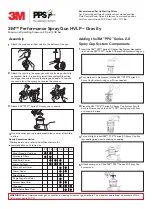
EN
158
EN
159
Troubleshooting
No emission of coating
material
Nozzle / Feed tube clogged
Clean
Material volume too low
Increase volume (+)
Feed tube loose
Tighten
No pressure in container
Tighten container
Coating material drips
from nozzle
Nozzle loose
Tighten
Nozzle or nozzle seal worn
Change
Coating material build up on air
cap, nozzle or needle
Clean
Atomisation too coarse
Too high viscosity of material
Thin material
Material volume too high
Decrease volume (–)
Nozzle contaminated
Clean
Air filter heavily soiled
Change
Too little pressure in container
Tighten container
Spray jet pulsates
Container empty
Refill
Air filter soiled
Change
Charge battery
Plug the charger (not included) into a suitable
wall socket.
Caution!
Only use the battery
charger specified in technical data
to charge the battery.
Slide the battery
(not included) onto the
charger and check its LEDs:
Red:
Charging
Green:
Battery is fully charged
Flashing Red:
Battery is defective
Flashing Green:
Battery is too hot/ cold
Technical Data
CORDLESS SPRAY GUN
PE-20 FSP
Nominal voltage
20 V
Max. viscosity
50 DIN-s
Container capacity
800 ml
Nozzle size
ø 2.5 mm
Flow rate
500 ml/min
Sound pressure level (L
pA
)
72.7 dB(A) / Uncertainty K = 3 dB(A)
Sound power level (L
WA
)
83.7 dB(A) / Uncertainty K = 3 dB(A)
Max. vibration emission
< 2.5 m/s
2
SUITABLE BATTERY
PE-AK2, PE-AK4
Voltage
20 V
Capacity
PE-AK2 (6801240): 2.0 Ah Li-ion battery
PE-AK4 (6801241): 4.0 Ah Li-ion battery
Operating temperature
10-40 °C
Storage temperature
10-25 °C
SUITABLE CHARGER
PE1H
Nominal voltage
100-240 V ~ 50/60 Hz, 78 W
Output voltage
14.4-20 V , 3.0 A
Charging time
60 min for PE-AK2
120 min for PE-AK4
Operation temperature
10-40 °C
Protection Class
/ II
Weight
0.25 kg
Noise & Vibration
The declared vibration total value and the de-
clared noise emission values have been meas-
ured in accordance with a standard test meth-
od (EN 60745) and may be used for comparing
one tool with another. The declared vibration
total value may also be used in a preliminary
assessment of exposure.
Caution!
The vibration and noise
emission during actual use of the
power tool can differ from the declared to-
tal value depending on the ways in which
the tool is used, in particular, what kind of
work piece is machined.
It is necessary to identify safety measures to
protect the operator that are based on an es-
timation of exposure in the actual conditions
of use (taking account of all parts of the op-
erating cycle such as the times when the tool
is switched off and when it is running idle in
addition to the trigger time)
Try to minimize the impact of vibration and
noise. Exemplary measures to reduce vibra-
tion exposure include wearing gloves while
using the tool, limiting working time, and us-
ing accessories in good condition.



































